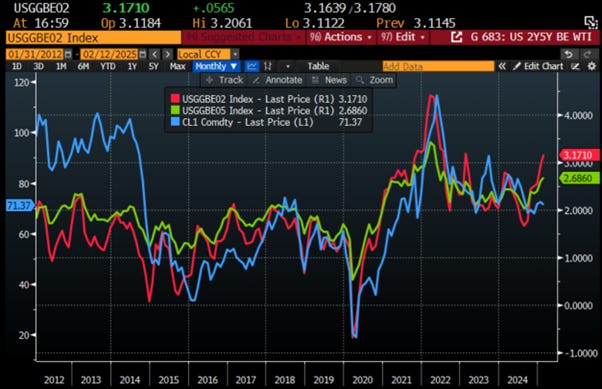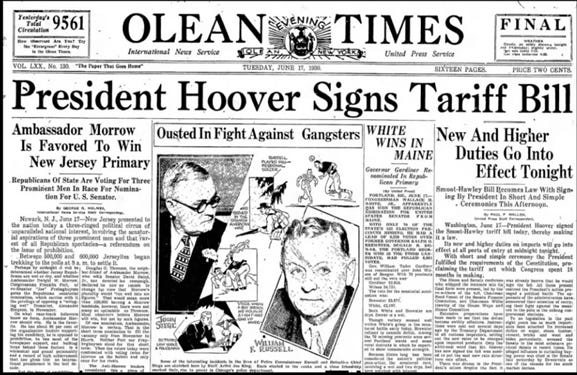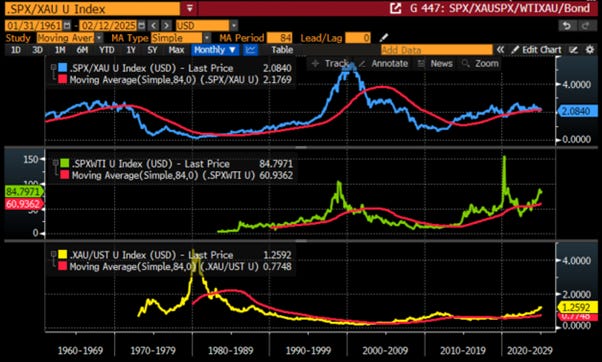What’s behind the numbers?
The first U.S. CPI data for the Jubilee Year rose by 0.5% MoM, exceeding expectations of +0.3% and up from December's 0.4% increase. As the disinflationary base effect continued to fade, the YoY increase reached 3.0%, surpassing both expectations and December's yearly pace of +2.9%. Energy turned inflationary for the first time since July last year, while the trend in food prices remained as high as in December.
The core CPI rose by 0.4% MoM in January, exceeding expectations of +0.3% and December's +0.2% increase. On a YoY basis, core CPI climbed 3.3%, above expectations of +3.1% and December’s +3.2%, marking the highest MoM change since March 2024 and the largest yearly increase since last November. Core services, which account for 76% of the core CPI index, slowed from +3.47% YoY to +3.28%, while core goods remained deflationary on a yearly basis, though less so than in December. Notably, this marks the 56th consecutive month of MoM core CPI increases.
As an encouraging sign for those who still believe inflation has been defeated, the Owners' Equivalent Rent (OER), a key measure of inflation persistence, rose by 4.6% YoY in January, down from December's 4.8% and marking its lowest level since March 2022.
Less encouraging and providing further evidence that inflation is far from defeated, the SuperCore YoY change was nearly unchanged, edging down from +4.05% in December to +4.02%. This remains well above a level that would signal the end of the inflation fight and should be unacceptable for a Federal Reserve chair who continues to insist he is committed to combating inflation for the good of the American people.
Market reactions.
U.S. stocks closed mixed after opening with notable downside, as equities pared losses, with the Nasdaq outperforming the S&P 500 and the Dow. However, all three major U.S. equity indices remain above their respective 50-day moving averages and in a bullish short-term trading pattern as of the market close.
Gains were driven by defensive and growth sectors like Consumer Staples; Communication Services and IT, while cyclical and rate sensitive sectors such as Materials; Real Estate and Energy underperformed.
The U.S. CPI data, which exceeded expectations, reinforced the view that the FED's pause will extend longer than previously anticipated. The first rate cut of the jubilee year is now projected for September with a 77% probability, while only two cuts are priced in for the entire year.
The dollar initially strengthened but later reversed course, ending the day below 108 on the DXY, driven by the prospect of negotiations between Putin and Trump despite the lack of fresh catalysts.
Gold consolidates from its fresh all-time highs as investors assess the impact of potential easing geopolitical tensions in Eastern Europe.
After the hotter-than-expected CPI report, the US 10-year yield rebounded above its 50-day moving average (4.50%), resuming its uptrend and closing above 4.60%. With markets bracing for the next phase of the reflationary path, new highs are expected in the coming months.
Thoughts.
The January CPI, the first inflation report following the inauguration of the 47th U.S. president and prior to the implementation of a tariff-focused trade policy, confirmed that the reflationary slow burn that began under the 46th president will soon be rebranded as 'Trump-Re-Flation.' New inflationary policies, such as higher tariffs and stricter immigration measures, are poised to accelerate this trend in the months ahead. In this environment, investors should prepare for rising goods inflation driven by import tariffs and persistent services inflation, which remains above 3% YoY due to labour constraints. This is already evident in the 'wisdom of the crowd' umbrella inflation index, which aggregates key U.S. inflation measures—including CPI, Core CPI, PPI, Core PPI, Core PCE, and 1-year Consumer Inflation Expectations—showing a YoY increase of 3.2%. Notably, none of these six inflation metrics is even close to the 2% target.
US Umbrella inflation Index (Average of CPI; Core CPI; PPI; Core PPI; Core PCE, 1-year consumer inflation expectations)
With the 'US Umbrella Inflation Index' already indicating that the disinflationary base effect is over, and reflation has begun, anyone with a modicum of common sense should expect the U.S. 10-year yield to rise well above the current 4.5% level. Meanwhile, the bond market appears to have already anticipated the upcoming 'Trump-Reflation,' with the 2-year and 5-year breakeven rates trading at their highest levels since June 2022, back when inflation was still supposedly 'transitory’.
US Umbrella Inflation Index (blue line) US 2-Year Inflation Breakeven (red line); US 5-Year inflation Breakeven.
In fact, the bond market, which consistently anticipates future trends better than any other financial market, appears to have already signalled an impending sharp rebound in oil prices, with the 2-year and 5-year breakeven rates trading as if WTI were at $90 or higher.
WTI price (blue line); US 2-Year Inflation Breakeven (red line); US 5-Year inflation Breakeven.
In this context, rather than sustaining the political illusion that the 2% inflation target is achievable within the next 12 to 24 months, or even beyond, investors, likely savvier than the thousands of PhDs at the Fed and Wall Street firms, understand that hitting 2% before the end of 2025 is highly unlikely, especially with the supposedly most beautiful word in the English dictionary (i.e., tariffs) still awaiting implementation in the coming months.
Anyone familiar with base effects can draw the following conclusions:
Returning to 2% inflation by the end of 2025 would require monthly CPI increases to average below 0.1% for the rest of the year.
If monthly inflation rises to 0.3% or higher over the next 12 months, as has been the case over the past three months, year-over-year CPI could reach between 4.0% and 6.3% by year-end. This scenario could force the FED to acknowledge its partisan driven policy misstep in easing during an inflationary boom in the U.S. economy.
While central bankers and politicians keep peddling the fantasy of a return to a 2% inflation target, the reality is that the 47th U.S. president, with his tariffs and trade war, is setting the stage for a financial disaster reminiscent of the Great Depression. Just as the Smoot-Hawley Act didn’t singlehandedly cause the 1930s crash, despite what some common wisdom would believe, tariffs today are more symptom than cause. Like in the 1930s, the economic decline was already underway before the start of the 47th US presidency, and like in the 1930s, traders will be reacting long before the legislation is signed. Like in the 1930s, the inevitable Sovereign Debt Crisis first in Japan and the Euro-zone will overlooks the fact that protectionism has been around far longer than Smoot-Hawley itself in 1930s or the Trump tariffs in the 2020s.
The misguided theories about tariffs and currency manipulation, dating back to the days when money was gold and silver, are as outdated as they are absurd as a way to solve the issues of imbalanced trade relationships. At the end of the day, inflation arises from three causes—shortages, demand, and lack of confidence, and in this context, tariffs, trade wars, and the threat of imperialistic behaviour from the U.S. will only exacerbate shortages and erode global confidence in public institutions, first abroad and ultimately in the US itself. The economy is and will always be the biggest factor in government approval. Trump will quickly lose support if his tariff measures lead to inflation, and you can forget it if he actually sent Americans back to the Middle East to satiate his colonialist property dreams.
What Trump and his advisors fail to grasp is that inflation can stem from asset shortages, speculative booms, and currency declines. Much like Hoover misunderstood the 1931 European sovereign defaults, which boosted the dollar and sparked tariffs, Trump’s tariffs may backfire. Political turmoil in Canada, combined with 25% tariffs, could drive the Canadian dollar to new lows, potentially as low as 46-50 cents, effectively undoing the intended effects of his tariff policies.
US imports from Canada (blue line); CAD/USD FX Rate (axis inverted; red line).
Even before tariffs take full effect, inflation has reaccelerated across many goods, driven by factors beyond the control of central banks or governments, such as climate cycles and disease disrupting supply chains. For instance, US egg inflation is running at +53% YoY and shows no signs of abating, highlighting the growing shortages and the troubling prospect of paying more for less.
US CPI Eggs (blue line); US CPI Eggs 12-month rate of change (yellow histogram).
Savvy investors know that instead of relying on the CPI, which is and will remain manipulated by politicians, they should assess inflation through the lens of gold’s performance against government bonds. As gold remains the ultimate hedge against reckless government policies, with the gold-to-U.S. Treasury ratio above its 7-year moving average since July 2019 and rising, the U.S. remains in an inflationary environment despite political or economic rhetoric.
Gold to US Treasury ratio (blue line); 84-month Moving Average of Gold to US Treasury ratio (red line).
Bottom line: Any savvy investor would recognize that those advising the 47th U.S. president lack a fundamental understanding of the global economy. The U.S. cannot thrive domestically while the rest of the world contracts under tariffs, leading to a crash-and-burn scenario. The key to global stability lies in 'mercantilist free trade,' and just as past wars and civil unrests drove inflation, holding hard assets like physical gold and actively trading equities, rather than relying on long-dated bonds, is the best strategy to preserve wealth amid structural inflation caused by supply shortages and imperialistic economic rhetoric. Those who still believe that tariffs and trade wars bring domestic prosperity while spreading poverty abroad will be remembered as the architects of their own nation's economic downfall.
Key takeaways.
The January CPI report highlights that while core services and shelter inflation have eased, reaccelerating energy and food prices will keep inflation persistently sticky, even before the impact of tariffs and immigration policies affect other good prices in the coming year.
January's CPI confirms that the 'Trump-Re-Flation' is underway, as tariffs and labour constraints drive inflation higher, ensuring long-dated U.S. Treasury yields rise despite the 47th president’s push for lower rates.
Inflation stems from shortages, demand, and declining confidence, all exacerbated by tariffs and trade barriers that stifle free mercantilism.
While the FED may believe that savvy investors fail to grasp the impact of base effects, the reality is that reaching 2% inflation beyond end of 2025 is an increasing phantasmagorical illusion.
Inflation will reaccelerate due to food shortages and rising energy costs, straining household finances and spreading stagflationary vibes.
In an inflationary bust, investors need to understand that protecting their wealth involves avoiding long-dated government bonds and focusing on a combination of equities from companies that can maintain pricing power with strong balance sheets and robust business models and physical gold as THE antifragile asset.
As stagflation rather than recession worsens in the next few months, investors should prepare their portfolios for HIGHER volatility.
In this context, investors should also remain prepared for dull inflation-adjusted returns in the foreseeable future.
With the S&P 500-to-gold ratio struggling around its 7-year moving average even before the 47th US president is inaugurated, investors should remain aware that, while the US economy is currently in an inflationary boom, it may be only 6 to 9 months away from shifting into an inflationary bust (i.e., stagflation). STAGFLATION will be painful for investors who haven't prepared their portfolios for this scenario. In this environment, people will buy even less for even more, and it will be challenging for those still blindly following Wall Street's ‘Forward Confusion’ narrative of seeking refuge in long dated fixed income papers and government bonds. Physical GOLD remains the only antifragile asset to thrive during an inflationary bust.
Bottom line: Despite the FED’s 100 bps rate cuts over the past 5 months, the 10-year yield has risen even more, exposing the FED Chair’s political impotence even ahead of an inevitable ‘Trump-Re-Flation’. As everyone knows, history shows that collapsing public confidence, fuelled by political instability and wars, leads to economic turmoil and this decade will be no different, as the 'Trump Stagflation,' will force everyone, from billionaires to everyday citizens, to pay more for less.
To navigate the coming volatility, investors should favour low-leverage companies with strong EPS and FCF growth, prioritizing energy producers over consumers as the U.S. joins the global inflationary bust, soon known as 'Trump Stagflation.' In fixed income, avoid long-dated bonds, especially government debt beyond six months, and actively manage cash through sub-12-month investment-grade corporate bonds. Ultimately, replacing long-term bonds with more than 25% allocation to physical gold, silver, and hard commodities will provide antifragile protection, as scarcity premiums rise amid a looming sovereign debt crisis, first in Japan and Europe, then inevitably in the U.S., where the 47th president, like his predecessors, repeats failed policies while expecting different results.
If this report has inspired you to invest in gold, consider Hard Assets Alliance to buy your physical gold:
https://www.hardassetsalliance.com/?aff=TMB
Disclaimer
The content provided in this newsletter is for general information purposes only. No information, materials, services, and other content provided in this post constitute solicitation, recommendation, endorsement or any financial, investment, or other advice.
Seek independent professional consultation in the form of legal, financial, and fiscal advice before making any investment decisions.
Always perform your own due diligence.




























WisdomTree Efficient Gold Plus Gold Miners Strategy Fund, ticker GDMN